|
Type VII B & C U-Boats
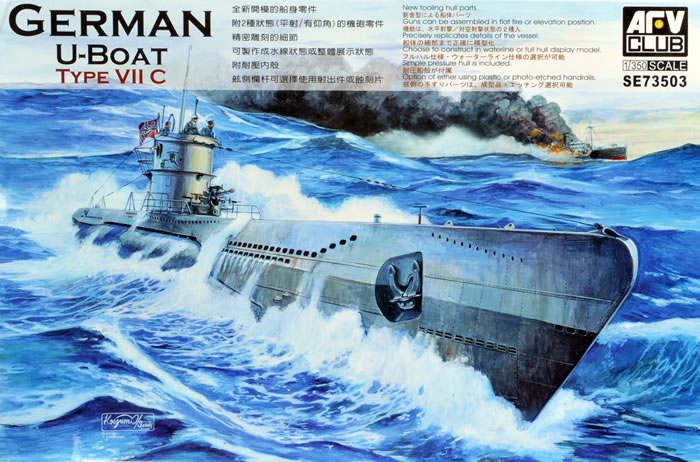
Revell and AFV Club, 1/350 scale
S u m m a r y |
Catalogue Number and Description |
Revell No. 05093 Type VII C U-Boat,
AFV Club No. SE73502 Type VII B U-Boat,
AFV Club No. SE73503 Type VII C U-Boat. |
Contents & Media |
Revell, 25 light grey plastic parts on 5 sprues, decals for 3 boats plus a 4 page instruction booklet with history, parts plan, 16 build diagrams and a 2 page paint/decal guide.
AFV Club, 61 olive drab plastic parts (60 for the C) on 3 sprues plus a separate Water-line upper hull, decals for 3 boats, 1 PE fret with 7 parts (16 for the C) plus a 3 page fold-out instruction sheet with history, parts plan, 8 build diagrams and a 1 page pain/decal guide. |
Scale: |
1/350 |
Price: |
AFV Club kits around AUD$25.00. Distributed in Australia by J.B. Wholesalers |
Review Type: |
First Look |
Advantages: |
All three are highly detailed and a big improvement on the Mirage kits. All have the railings moulded in plastic which are almost to scale while the AFV Club kits also comes with a PE option for the railings. The AFV Club kits also have a Water-line/Full Hull option. |
Disadvantages: |
AFV Club kits have some fit problems (easily fixed) particularly with the Full Hull option, some errors in the instructions and iffy colour recommendations. The PE fret in the AFV “B” kit is over scale.
The Revell kit is a bit overdone in the detail department, showing all of the rivets from the 1/144th and 1/72nd scale kits and the flooding holes are not deep enough and will require a black wash. The Revell kit does not supply a wind deflector for the top of the tower or the torpedo site, both of which are in the AFV kit. |
Conclusion: |
A few years ago, I bought a heap of Mirage U-Boat kits only to discover I couldn't handle the PE for them. These kits are the answer. Yes, the plastic railings are a little over scale as you will see from the photos of the VII B which I started building before beginning this review and is also why there are no shots of the VII B sprues. |
Reviewed by
Glen Porter

AFV Club's 1/350 scale Type VII C U-Boat is available online from Squadron.com
The Type VII U-Boat was the mainstay of Germany's WW II U-Boat Arm. The VII A was based on a WW I design and although showing promise, lacked power and endurance. Only 10 were built and all were relegated to training duties before the war began. The VII B, 24 built, had more powerful engines and the 3 top early war Aces, Otto Kretschmer (U-99), Gunther Prien (U-47) and Joachim Schepke (U-100) all got the majority of their kills in Type VII Bs. All three were sunk within 10 days of one another, U-99 and U-100 on the same day and only Kretschmer and his crew survived.
The Type VII C had the endurance that the “A” and “B” lacked and was chosen for mass production with over 600 built by the end of the conflict. Many modifications were done on them as the war situation changed and some were retro fitted to the Bs.
There was a Type VII D and F, the E was a project only, but they were specialized mine or torpedo carriers.
For many years, we've had only the Heller and Mirage U-boat kits in 1/400th scale and then Revell gave us the incredible 1/72nd scale Type VII C. This was followed with a 1/144th scale version of the same kit and now they have done it in 1/350th scale. What's more, AFV Club have also released 1/350th scale Type VII B & C kits and Bronco from China have also shown some interest in German WW II U-boats.
Boy, when it rains, it pours!
The AFV Type VII B kit. I'd already started building this kit before I received the other two but most of the parts are identical to those in the “C” kit with the exception of the two tower halves, PE fret, box art, instructions, decals and a couple of extra plastic parts. Even so, I've included some shots of it partially built to show that the rails look quite good even though they are a little over scale.

The Type VII Bs were initially built with a tower very similar to the “A”, with a small “Winter Garden” and the 20mm A/A gun mounted on the casing behind the tower. This was soon found to be too “wet”and a larger “Winter Garden” was added to mount the A/A gun, resulting in the odd shape of the tower trailing edge on most “Bs”. Although AFV give you two complete towers, they don't supply this early example and the two are almost identical except for the amount of steps going up the sides.
The hull comes in three parts, two lower hull halves, split vertically, and the upper hull which is used by itself if you choose to build a water-line model. The detail on these three is exceptional with the flooding holes being deep enough not to require any pre-shading. I am led to believe that there were differences between the “B” and “C” hulls, mainly in the side flooding vents in the casing and if this is correct, this “B” kit has a “C” hull. AFV also supply the top half of the pressure hull to go between the two lower hull parts. In my opinion, this is a waist as when the top hull is glued on it can't be seen and if the top bit is left unglued so as to view the pressure hull, the detail is not good enough.
I mentioned above, the existence of a fit problem in the AFV kits. When the two lower hull parts are glued together, the centre section (saddle tanks) is slightly narrower than the upper hull. This can be fixed in one of two ways. Either fit spreaders of plastic card or sprue to this section to widen it a bit, or use the pressure hull between the lower parts and slide appropriate sized bits of sprue down between the pressure hull and lower hull sides to spread the centre section. Fortunately, the upper and lower join is on the colour demarcation as there is so much detail around the join that it's almost impossible to clean it up.
The AFV Type VII C kit. Some small improvements have been added to this kit over the Type VII B. First of all, the PE set in the “B” kit was way over scale and only included the deck railings, aft cable supports and D/F loop. The set in the “C” kit, now to scale, also has the Winter Garden rails, ensign staff for the Winter Garden, steps to go up the side of the tower and a complete set of jumper cables including insulators, totaling 16 parts compared to the “Bs” 7.
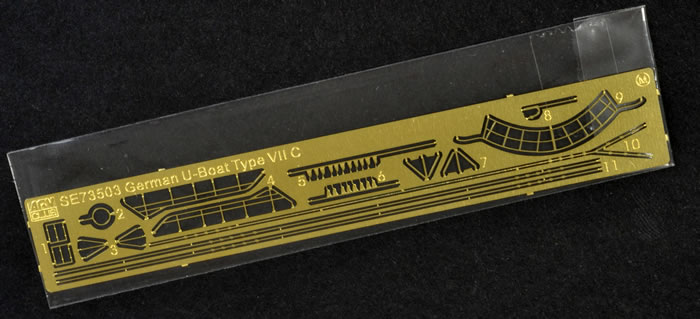
The plastic parts are almost identical in both except for the tower (1 in the “C” as apposed to 2 in the “B”), an extra A/A gun in the raised position and a plug for the aft torpedo tube. The plastic in both is a little on the brittle side and I had several very small parts break when I tried to remove them from the sprue.
Decals in both kits are reasonable although nowhere near as good as Revell's.
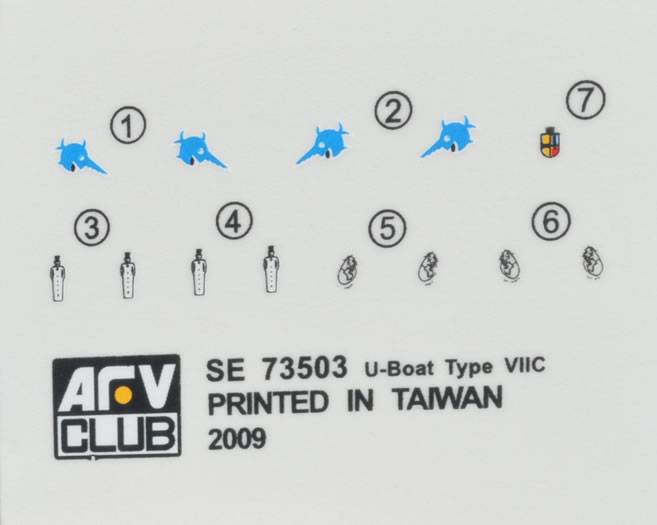
The “B” kit has U-47, U-99 and U-48 but the colour recommendations are not accurate with Prien's U-47 with a red lower hull and Kretschmer's U-99 in camouflage. The “C” kit has U-96, U-558 and U-201. For accurate info on these boats for all three kits, I would suggest you Google U-boat Colours.
Revell's 1/350 scale Type VII C
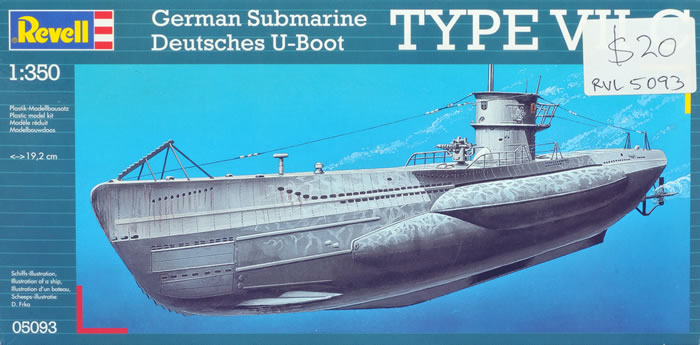
The Revell Type VII C kit. Having a smaller parts count than the two AFV kits and not having the “water-line” option, this kit would appear to be considerably cheaper than the two above.
It would seem to be based on the two larger scaled Revell kits to the point that all of the rivet detail on the hull and tower from them is present on this 1/350th scale kit which to my mind is over-doing the detail thing a bit. Conversely, much of the detail that should be visible, such as hull flooding vents, is a bit soft.
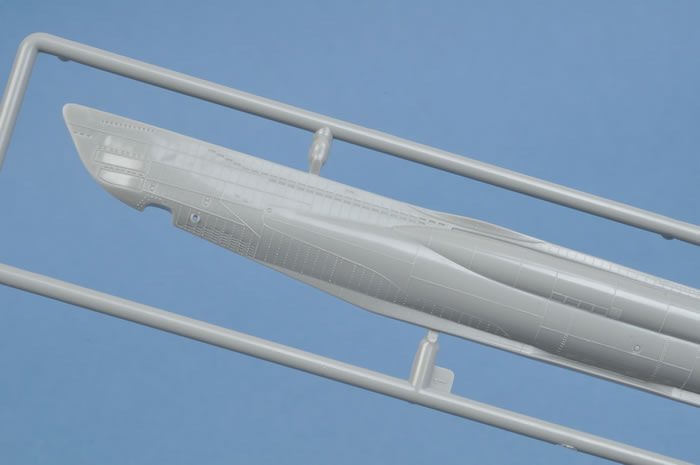
Like the two above kits, Revell has included the railings in plastic with no PE option but unlike the AFV kits the mounting point for the hull rails is not right on the edge of the hull but about 1mm in on the decking. A small point I know, but in this scale it may stand out.
Tower detail is quite good, both inside and out, but Revell forgot the wind deflector from the front top edge of the tower. It is rare to see a photo of a Type “C” without this deflector although some do exist. The D/F loop is moulded integrally with the right tower side and is way over scale and would perhaps be better removed. Revell represents the torpedo sight on the tower as just a tapered pin with no detail although two separate and nicely detailed periscopes are present.
There are several other small detail part which are in the AFV kits that are not included in Revell's example and the anchor is moulded in situ on the starboard bow. The bow cable cutter in my Revell kit was badly distorted however, most late Type “Cs” did not have them fitted. Most other small parts in the Revell kit are not quite as fine as in the AFV kits but still quite acceptable.
Decals from Revell are far superior to AFV's and also cover three boats. U-81, in the Med, 1942. This is the boat that sank HMS Ark Royal on the 13th of November, 1941 and is depicted in light and black grey with black grey panels extending up the hull and tower sides. U-96, in the Atlantic, 1940-43, in dark and black grey with the blue laughing swordfish on the tower. U-552, Atlantic, 1942. This is Erich Topp's boat in light and black grey hull and mid grey tower with red devil and raging bull markings on the tower sides. His claim to fame was the sinking of the USS Reuben James while the US was still neutral. Unfortunately, Revell has put U-255 on the decal sheet instead of U-552.
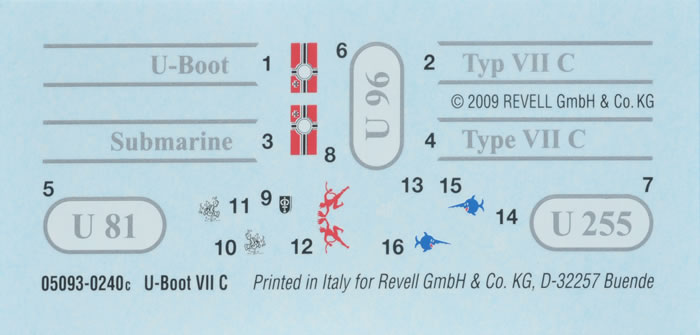
Revell's instructions are better than AFV's with clearer build diagrams and more info in the colour recommendations except that the colours are only in Revell's own paints. There is also considerable detail on each of the subject in the colour instructions.
Overall, I prefer the AFV kits because of the better detail and extra parts but the Revell kit is, in my opinion, still worthwhile. It's a pity about that missing wind deflector but if you happen to have the AFV Type “B” as well, it also has the deflector which can be used in the Revell kit.
Post Script
Since starting this review/comparison, I have begun work on the Revell kit and can tell you care should be taken aligning the two halves of the hull. I didn't and it cause considerable trouble in the clean-up and with the fitting of other small parts.
Samples purchased by the reviewer
Review Text Copyright © 2009 by Glen Porter
Images Copyright © 2009 by Brett Green
Page Created 28 October, 2009
Last updated
28 October, 2009
Back to HyperScale Main Page
Back to Reviews Page |
